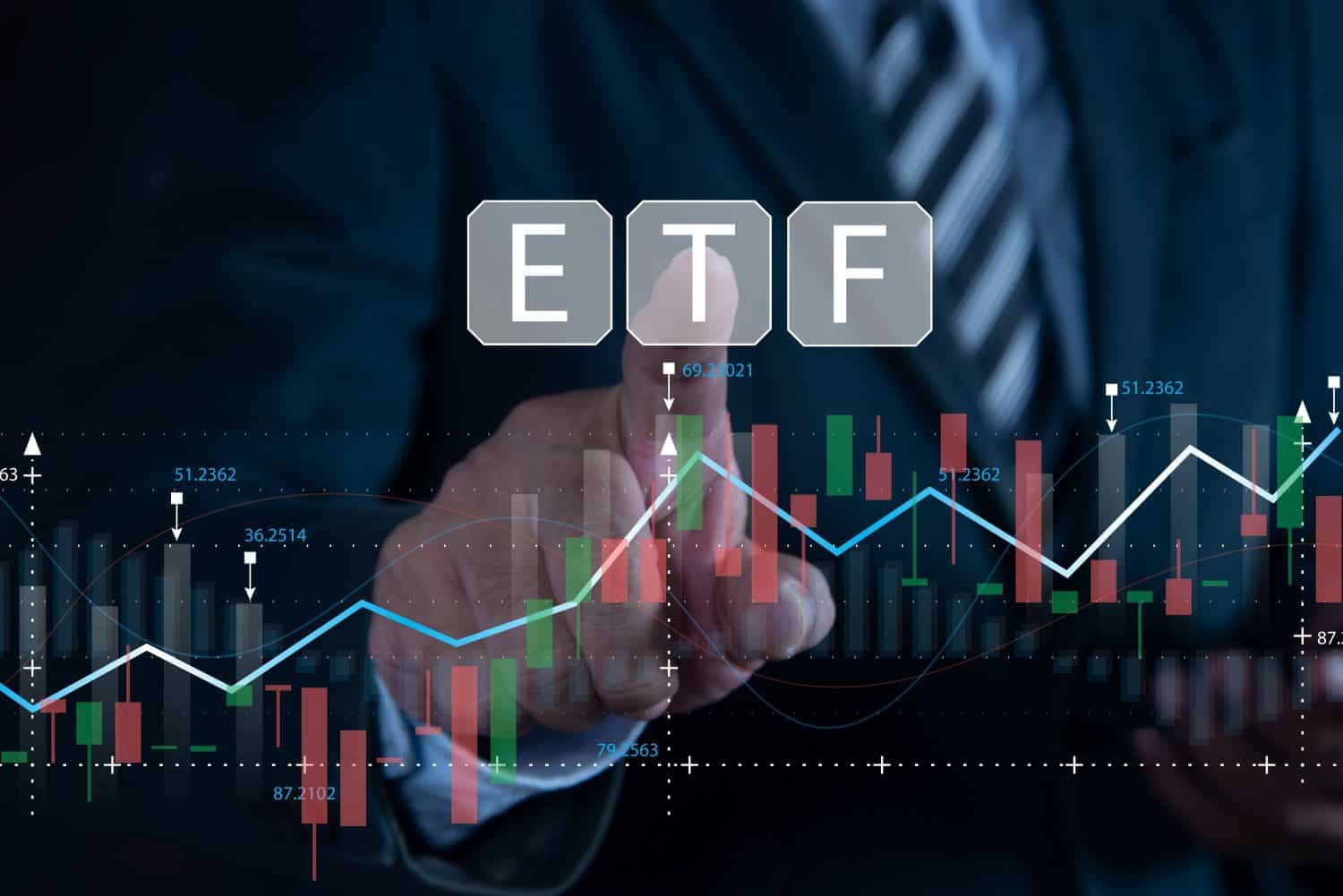Investing
7 Top ETFs to Buy For Huge Passive Income In February

Published:
Last Updated:

While most citizens in general are hurt by higher interest rates and their correspondingly higher product and service prices due to inflation, there is one demographic that seizes opportunity in those periods: income-oriented investors.
Higher interest rates suppress bond prices as yields rise, making the purchase of bonds cheaper, allowing investors to lock in higher yields. Although a majority of bond buying is conducted for capital preservation and safety, income oriented investors also can consider other options, such as dividend stocks, for their portfolios. However, there are some drawbacks to this approach:
Many income oriented investors lack the available time to monitor a portfolio of dividend stocks, thus leaving higher yields on the table for lower yielding bonds.
A number of income focused ETFs combine the benefits of diversification with sector concentration for investors seeking exposure in specific industries.
Given their inherent diversification risk, ETFs require less daily monitoring than a portfolio with individual stocks.
4 million Americans are set to retire this year, and having the right investments can put you well on your way. If you want to join them, click here now to see if you’re behind, or ahead. It only takes a minute. (Sponsor)
High Yield Exchange Traded Funds (ETF) have short histories and are still relatively new, with most launching after 2000. Nevertheless, they can address many of the concerns for investors interested in some of the higher yields that can be obtained through equities with larger than normal dividends and high yield bonds that carry higher level of default risk.
The combination of securities in ETFs offers diversification to mitigate risks from individual stocks’ volatility, and some are sector based, thus offering an investor portfolio diversification by industry as well as by security name. The following ETFs below are based on market quotes at the time of this writing, and put a viable alternative to mutual funds or bonds on the table for investors seeking large passive income holdings.

USA Global Sea to Sky Cargo ETF (NYSE: SEA)
Yield: 19.39%
The fascinating world of logistics, shipping, and transportation is the primary key to how the planet Earth has become a smaller place over the past few centuries. Intrepid explorers throughout history, from Marco Polo to Christopher Columbus, Sir Walter Raleigh, and many others, were all motivated by the desire to make their fortunes through trading with other nations to obtain goods unavailable in their homelands. Transportation of cargo ranging from food, equipment, electronics, textiles, etc. are tightly interwoven into the global economy. Supply chain disruptions, such as the 2021 Suez Canal 6-day blockage from the stranded container ship Ever Given, created a huge domino effect that affected supply chains globally.
The USA Global Sea to Sky Cargo ETF offers investors exposure in this unique sector. Many of the stocks it contains are well-known names. The yields from shipping company stocks can also be very high, but often are contingent upon trade route activity, the type of cargo that may be transported, and the maintenance and replacement costs for maritime and aircraft fleets.
The top 10 holdings of SEA feature many international shipping companies, unsurprising given the nature of global trade and import-export activity.
|
Symbol/Exchange |
Company |
Percentage |
|
1919 (HK) |
Cosco Shipping (China) |
5.25% |
|
HAFNI (Oslo) |
Hafnia Ltd. (Norway) |
4.98% |
|
HAUTO (Oslo) |
Höegh Autoliners ASA (Norway) |
4.77% |
|
1308 (HK) |
SITC Holdings Co. Inc. (Hong Kong) |
4.62% |
|
ZIM (NYSE) |
ZIM Integrated SHipping Services Ltd. (Israel) |
4.61% |
|
MAERSK.B (Copenhagen) |
A.P. Møller – Mærsk A/S (Denmark) |
4.48% |
|
0316 (HK) |
Orient Overseas International Ltd. (Hong Kong) |
4.21% |
|
TRMD.A (NASDAQ) |
Torm PLC (UK) |
4.19% |
|
STNG (NYSE) |
Scorpio Tankers, Inc. (Monaco) |
4.08% |
|
9101 (Tokyo) |
Nippon Yusen Kabushiki Kaisha (Japan) |
3.99% |
Internationally, SEA’s holdings break down as: United States – 27.26%, Hong Kong – 22.91%, Norway – 15.01%, Japan – 9.88%, Denmark – 8.67%.
Launched in 2022, SEA has 31 holdings and $6.16 million in net assets. Its expense ratio is 0.60%. SEA also has options trading availability.

iShares Emerging Markets Dividend ETF (NYSE: DVYE)
Yield: 11.79%
Many emerging market nations represent tremendous upside opportunities that are not necessarily reflected in the US economy and often are not on a sufficiently large enough scale to warrant widespread coverage in international news. Nevertheless, they can equate to significant gains for shareholders, and with major economic gains in nations like Vietnam or Argentina, can deliver sizable yields.
BlackRock, which is the 800 lb. gorilla of the asset management world with over $11 trillion in its coffers, owns an enormous menu of financial products through its subsidiaries. iShares, BlackRock’s ETF division, has a foothold in every financial sector publicly available. Its iShares Emerging Market Dividend ETF is the BlackRock entry in the emerging markets arena.
With an inception date of February 23, 2012, DVYE tracks the Dow Jones Emerging Markets Select Dividend index as its benchmark. It has 102 holdings,and also has options trading availability. DVYE’s current AUM is $662.52 million. Its expense ratio is 0.49%, and its top 5 holdings are:
|
Symbol/Exchange |
Company |
Percentage |
|
PETR4 (Sao Paulo) |
Petróleo Brasileiro S.A. – Petrobras (Brazil) |
5.19% |
|
00939 (HK) |
China Constructions Bank (China) |
4.07% |
|
CEZ (Warsaw) |
CEZ Group (Czech Republic) |
3.65% |
|
VEDL (Mumbai) |
Vedanta Ltd. (India) |
3.60% |
|
2603 (Taipei) |
Evergreen Marine Corp. Ltd. (Taiwan) |
3.12% |

VanEck Mortgage REIT ETF (NYSE: MORT)
Yield: 11.56%
Real Estate Investment Trusts (REIT) are a popular way for investors to gain exposure to the solidly consistent income derived from real estate rent rolls and other real estate related activities. In order to be publicly listed, REITs must remit 90% of profits to shareholders. This gives REIT shareholders the income stream profits without the need to deal with the management headaches and responsibilities that come with brick and mortar properties or with managing mortgage portfolios and other real estate debt. One advantage of passive income generated from REITs that are focused on rental income is that they are a solid hedge against interest rate fluctuations.
Established in 2011, the VanEck Mortgage REIT ETF attempts to equal or exceed its MVIS US Mortgage REITs Index benchmark. It has 26 holdings and $299.5 million AUM. MORT also has options trading availability and carries a 0.43% expense ratio. Top 5 holdings include:
|
Symbol/Exchange |
Company |
Percentage |
|
NLY (NYSE) |
Annaly Capital Management |
13.57% |
|
AGNC(NASDAQ) |
AGNC Investment Corp. |
12.16% |
|
STWD (NYSE) |
Starwood Property Trust, Inc. |
8.10% |
|
RITM (NYSE) |
Rithm Capital Corp. |
7.78% |
|
ABR (NYSE) |
Arbor Realty Trust, Inc. |
4.80% |

Global X SuperDividend ETF (NYSE: SDIV)
Yield: 11.27%
Since ETFs are microcosms of indexes that are collections of securities by definition, combinations that group by specific criteria regardless of industrial sector are very common.
The Global X SuperDividend ETF invests in 101 of the highest dividend-paying companies from around the globe. SDIV tracks the performance of the Solactive Global SuperDividend Index as its benchmark. The worldwide equity exposure enables SDIV to diversify its holdings both in terms of geography and interest rate risks. Founded in 2011, this ETF has made consistent monthly dividend distributions for the past 12 years.
SDIV has a moderate expense ratio of 0.58%. Its AUM is $774.79 million, and it also has options trading availability. Its top 5 holdings are:
|
Symbol/Exchange |
Company |
Percentage |
|
0551 (HK) |
Yue Yuen Industrial Holdings (Taiwan) |
2.02% |
|
1310 (HK) |
HKBN Ltd. (Hong Kong) |
1.85% |
|
KNTK (NYSE) |
Kinetik Holdings Inc. (US) |
1.52% |
|
KEN (NYSE) |
Kenon Holdings, Ltd. (US) |
1.44% |
|
3618 (HK) |
Chongqing Rural Commercial Bank (China) |
1.37% |

JPMorgan Nasdaq Equity Premium Income ETF (NASDAQ: JEPQ)
Yield: 9.66%
Actively managed equity portfolios seeking to generate maximum income from a variety of sources will often deploy options strategies. This can include covered call writing. spreads, and other tactics for mitigating risk and boosting ROI. The JPMorgan Nasdaq Equity Premium Income ETF is one such example. Focusing on large cap NASDAQ issues, JEPQ analyzes growth trajectories of tech stocks and other fast moving equities. It buys the stock and then augments returns and lowers cost basis with covered call writing strategies.
JEPQ contains 93 holdings and has AUM of $22.78 billion. Its expense ratio is 0.35%. It launched in May, 2022, and has options availability. Top 5 holdings include, unsurprisingly, are all Magnificent 7 stocks.
|
Symbol/Exchange |
Company |
Percentage |
|
AAPL |
Apple Inc. |
8.97% |
|
NVDA |
Nvidia |
8.01% |
|
MSFT |
Microsoft |
7.81% |
|
AMZN |
Amazon |
6.48% |
|
GOOG |
Alphabet Class C |
5.53% |

Invesco CEF Income Composite ETF (NYSE: PCEF)
Yield: 8.81%
With such a gargantuan list of ETFs from which to choose, the S-Network Composite Closed-End Fund IndexSM is a benchmark for “fund of funds” ETFs, i.e., ETFs that buy stakes in other ETFs, rather than in specific stocks. The Invesco CEF Income Composite ETF is one such ETF fund of funds.
The PCEF agenda is to obtain an optimum level of income from various ETF holdings that will also satisfy diversification goals. As a result, the range of ETF holdings will include those holding high dividend equities, high yield bonds, international equities, and other asset classes.
Launched in 2010, PCEF holds 114 ETF names and has $837.19 million AUM. Its expense ratio is a high 3.08% and it has an options chain. The top 5 holdings are:
|
Symbol/Exchange |
Company |
Percentage |
|
EXG (NYSE) |
Eaton Vance Tax-Managed Global Diversified Equity Income Fund |
4.35% |
|
BIGZ (NYSE) |
BlackRock Innovation and Growth Trust of Beneficial Interest |
3.24% |
|
BMEZ (NYSE) |
BlackRock Health Sciences Trust II |
3.07% |
|
ETY (NYSE) |
Eaton Vance Tax-Managed Diversified Equity Income Fund |
2.80% |
|
JPC (NYSE) |
Nuveen Preferred & Income Opportunities Fund of Beneficial Interest |
2.56% |

SPDR Bloomberg High Yield Bond ETF (NYSE: JNK)
Yield: 6.63%
As the above ETF listings are equity-based, it only makes sense to include a high-yield bond ETF as well, in the spirit of diversity. State Street’s SPDR Bloomberg High Yield Bond ETF launched in 2007 and holds $7.86 billion AUM. Its expense ratio is 0.40%, and has an options chain.
The target bonds JNK aims to acquire are corporate issues with a maximum 15-year maturity and ratings of BB+ or lower. Its benchmark is the Bloomberg High Yield Very Liquid Index.
The Top 5 Holdings are:
|
Bond |
Maturity |
% hldg |
|
Medline Borrower LP 3.875% |
4/1/2029 |
0.45% |
|
Tibco Software Inc 6.5% |
3/31/2029 |
0.42% |
|
Cloud Software Group Inc. 9% |
9/30/2029 |
0.41% |
|
DISH Network Corporation 11.75% |
11/15/2027 |
0.38% |
|
Directv Financing LLC/Directv Financing Co-Obligor Inc. 5.88% |
8/15/2027 |
0.38% |
ETFs have escalated steeply in popularity with Gen-Z, Gen-X and Millennials, due to their relatively low expense ratios, and popularization on Reddit and other social media chat forums. High-growth ETFs are especially popular with those who pursue the F.I.R.E. (Financial Independence Retire Early) ethos. While the bulk of the ETFs are followed by growth-oriented investors, income investors, including the $720 Trillion in Baby Boomer wealth, are starting to take notice of income ETFs. Those who jump in earlier may very well get the upside of anticipated lower interest rates and higher prices under a pro-business President Trump economic policy.
Part of the reason why ETFs like USA Global Sea to Sky Cargo ETF have been on the lower end of their 52-week trading range has been due to the inflationary environment and resulting business slowdowns of the past 4 years. Apart from the technology sector, conventional business has been borderline recessionary, as high fuel prices and drastically reduced discretionary spending capacity put a damper on a wide range of economic activities.
February may very well be the last month to buy low. The resulting economic resurrection from Trump’s proposed tax and regulatory cuts are already signaling bullish anticipation in a number of industrial sectors. Locking in double-digit yields while the window of opportunity is still open can be an excellent dividend yield play for ETF income-based investors.
Retirement can be daunting, but it doesn’t need to be.
Imagine having an expert in your corner to help you with your financial goals. Someone to help you determine if you’re ahead, behind, or right on track. With SmartAsset, that’s not just a dream—it’s reality. This free tool connects you with pre-screened financial advisors who work in your best interests. It’s quick, it’s easy, so take the leap today and start planning smarter!
Don’t waste another minute; get started right here and help your retirement dreams become a retirement reality.
Thank you for reading! Have some feedback for us?
Contact the 24/7 Wall St. editorial team.